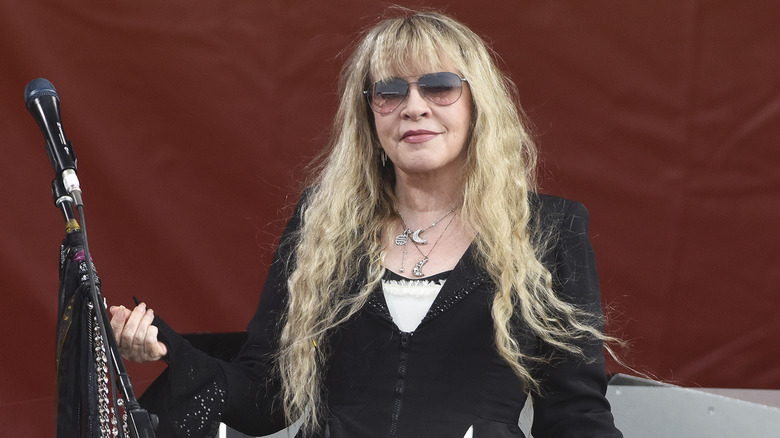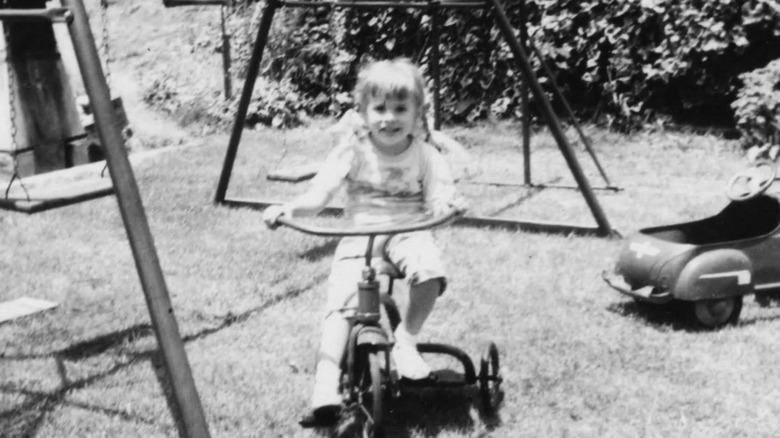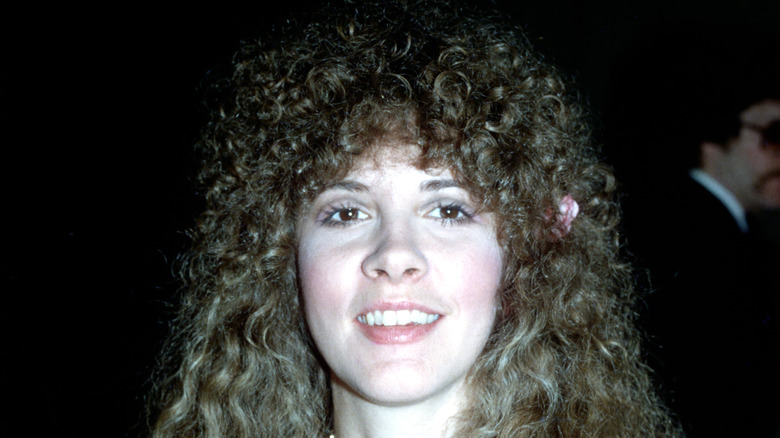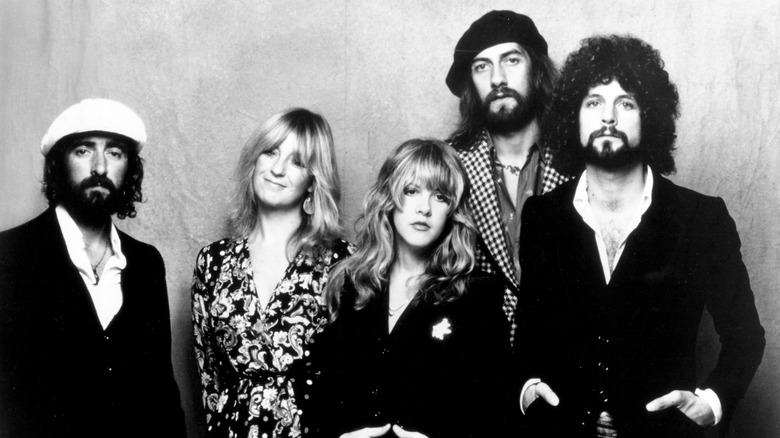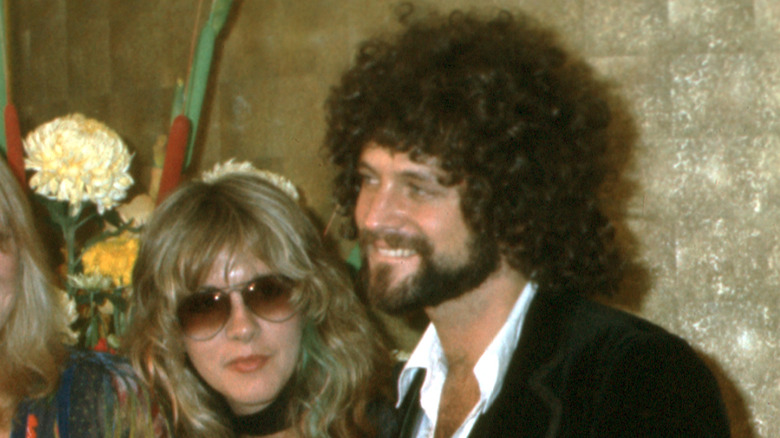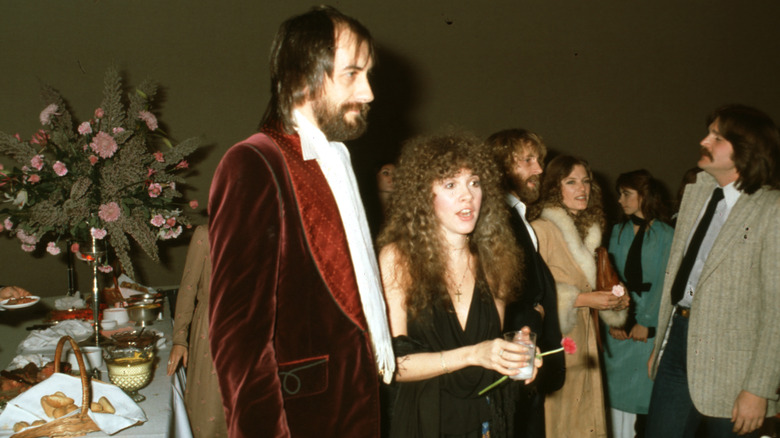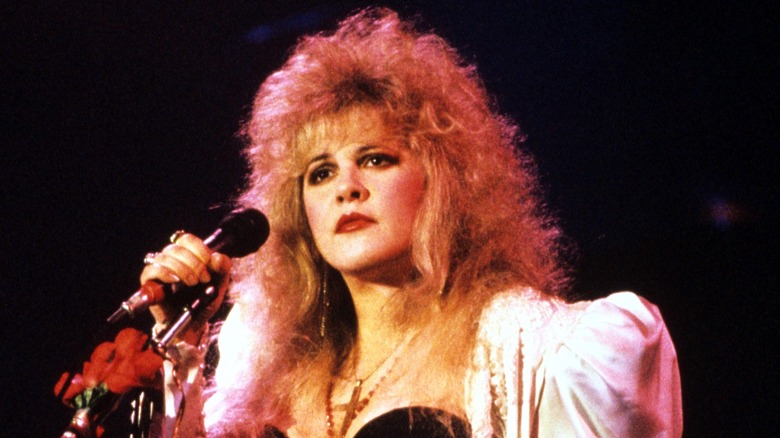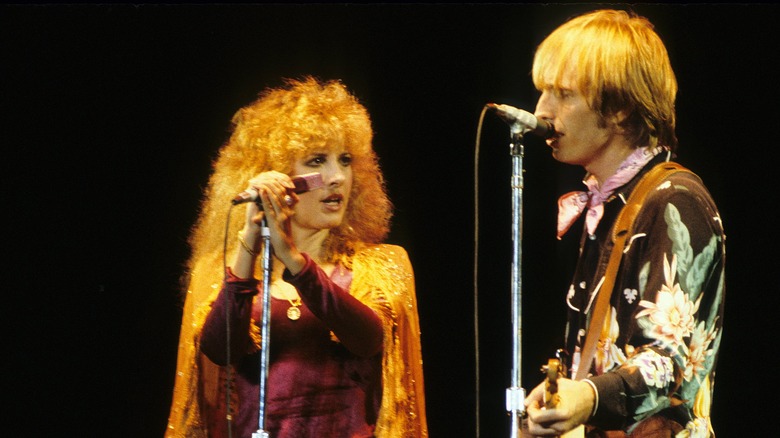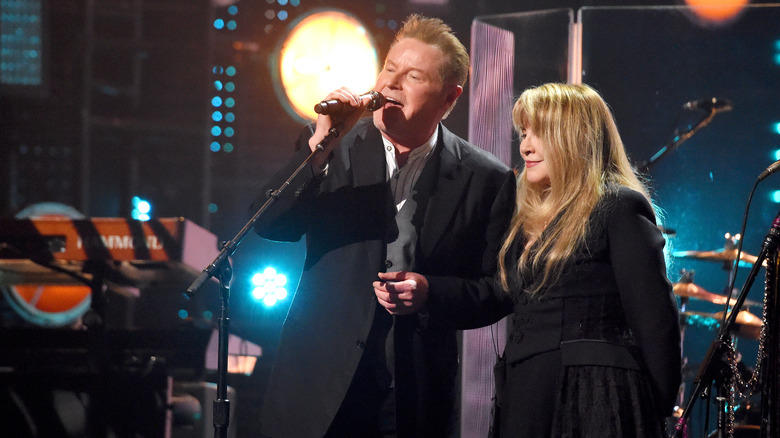The Transformation Of Stevie Nicks From Childhood To 75
Note: This article discusses substance abuse.
Ever since her emergence in the mid-1970s, Stevie Nicks has provided the musical soundtrack to fans' lives. From her seminal work with Fleetwood Mac to her numerous solo hits, Nicks' talents as a singer and songwriter have gifted the world with some of music's most iconic pop songs. That's backed up by her double inductions into the Rock and Roll Hall of Fame, as a member of Fleetwood Mac in 1998, and as a solo artist in 2019 — making Nicks the first woman to be inducted twice, and one of just three women (along with Tina Turner and Carole King) so honored as of this writing.
Having celebrated her 75th birthday in 2023, Nicks is also a survivor, having indulged deeply in the sex-drugs-and-rock-and-roll lifestyle that has claimed the lives of so many stars, yet lived to tell about it. She's also displayed no signs of slowing down; in the spring and summer of 2024, she's hitting the road for a new tour, bringing her music directly to fans as she's done for five decades and counting.
That journey has not always been an easy one. Throughout her lengthy career, she's experienced heartbreak, tragedy, devastating illness, and seemingly endless drama — and overcame it all, soaring high like the iconic "white-winged dove" described in one of her most memorable hits. To find out more about the tumultuous life of this talented star, read on to experience the stunning transformation of Stevie Nicks.
She grew up in her 'own little musical world'
Born Stephanie Lynn Nicks in Phoenix, Arizona, Stevie Nicks got her nickname due to the way she pronounced her own name as a child. When she was young, she also loved fairytales. "I would read Stevie the stories over and over, and she would just sit there enraptured," her mother, Barbara Nicks, told the Arizona Republic (via The Nicks Fix). Her mother, Stevie told Rolling Stone in 1980, was also overprotective. "All out of love," she insisted. "But I was kept in more than most people were."
Early on, the youngster was taken under the wing of her grandfather, a country singer who never attained the stardom he sought. Recognizing his granddaughter's talent, she was just five when he wanted to bring young Stevie onstage to sing with him (her parents refused, leading to a long family rift). Still, Stevie knew from an early age that her future lay within the realm of music. "I just wanted to listen to rockabilly and rock 'n' roll and R&B, and I just was in my own little musical world," Stevie told HuffPost.
When she was a teenager, Nicks told her parents she wanted to pursue a music career. They were hardly surprised, but her father Jess Nicks demanded excellence. "The only thing my dad ever said to me was — because my dad was very successful and very ambitious — he said, 'If you're going to do this, you better be the very best,'" she said in an interview with High Times (via The Nicks Fix).
Meeting Lindsey Buckingham changed the course of her life
Steve Nicks was an 18-year-old California high school student in Palo Alto, California when, while attending a party, she saw long-haired teenager Lindsey Buckingham playing his guitar and singing The Mamas and the Papas' "California Dreamin'." She sat down next to him and melded her voice to his, in perfect harmony.
"And then I didn't see Lindsey again for two years. The drummer in his band Fritz called me and asked if I wanted to sing with them," Nicks told Q Magazine (via The Nicks Fix). For the next three years, Buckingham and Nicks were bandmates, each dating someone else. That changed when the two decided to head to Los Angeles to launch themselves as a musical duo. "Our relationship happened because I wanted to move to L.A., and I don't think either of us would've been brave enough to get in the car and drive to L.A. alone," she explained of how they stumbled into becoming a couple.
The pair — dubbing themselves Buckingham Nicks — figured their big break had arrived when they were signed to a major label, and released their eponymous debut album. Unfortunately, the album went nowhere, and their label dropped them. To make ends meet, Nicks worked as a waitress, while Buckingham played guitar with The Everly Brothers' Don Everly on what ended up being a disastrous, aborted tour. Destiny, however, was waiting right around the corner.
A chance encounter led them to Fleetwood Mac
By late 1974, Fleetwood Mac was in disarray. Founded in 1967 as a blues outfit, the band had churned through a seemingly endless stream of singers and guitarists after the exit of original guitarist Peter Green. At that time, the remaining core group — drummer Mick Fleetwood, bassist John McVie, and his then-wife, singer/keyboardist Christine McVie — happened to come across Lindsey Buckingham in a Los Angeles recording studio. Fleetwood was impressed by Buckingham's skills as a guitarist and singer-songwriter and invited Buckingham to join the band. Buckingham accepted, but on one condition: Stevie Nicks would also join, as they were a package deal.
Both Buckingham and Nicks realized Fleetwood Mac could be the opportunity they'd been working toward. However, by that point, their relationship was already badly fraying. "We were breaking up when Fleetwood Mac asked us to join," Nicks told Billboard. "I said, 'OK, this is what we've been working for since 1968. And so Lindsey, you and I have to sew this relationship back up. We have too much to lose here.'"
They joined Fleetwood Mac, which now boasted three powerful vocalists who also wrote catchy pop songs. The fruits of this amalgamation were heard in the band's 1975 self-titled "Fleetwood Mac" album, which became the band's biggest success to that point thanks to such hits as "Monday Morning" (written by Buckingham), Nicks' compositions "Rhiannon" and "Landslide," and Christine McVie's "Over My Head" and "Say You Love Me."
Her relationship with Lindsey Buckingham was on the rocks
When Stevie Nicks and Fleetwood Mac entered the studio to work on their follow-up album, "Rumours," her relationship with bandmate and boyfriend Lindsey Buckingham had deteriorated even further. Meanwhile, John and Christine McVie's marriage was also unraveling, while Mick Fleetwood was in the midst of a divorce. Add monumental pressure and an unlimited supply of cocaine, and it's clear to see that wasn't the optimum environment to create a great album. "Imagine the tension of living with someone 24 hours a day, on the road, in an already stressful situation, with the added negativity of too much alcohol," Christine McVie told Rolling Stone of all the uncoupling going on at the time. "It just blew apart."
Despite those obstacles, "Rumours" became Fleetwood Mac's magnum opus, selling more than 40 million copies and becoming one of the top 10 biggest-selling albums in history. Powered by a string of hits — "Go Your Own Way," "Don't Stop," "Dreams," "You Make Loving Fun" — "Rumours" ruled Top 40 radio during 1977.
For Nicks, however, her greatest professional success was in direct contrast to the misery in her personal life as she and Buckingham split up while remaining bandmates. "When we broke up, two years after joining Fleetwood Mac, it was like a living nightmare," she told Woman's Own in 1990 (documented by a fan site). "He and I were about as compatible as a boa constrictor and a rat."
If you or anyone you know needs help with addiction issues, help is available. Visit the Substance Abuse and Mental Health Services Administration website or contact SAMHSA's National Helpline at 1-800-662-HELP (4357).
Her affair with drummer Mick Fleetwood was a bad idea
Amid all the relationship turmoil going on within Fleetwood Mac, an already-fraught situation became even more so when Stevie Nicks and Mick Fleetwood had a brief and very ill-considered affair. "Mick and I were absolutely horrified that this happened. We didn't tell anybody until the very end, and then it blew up and was over," Nicks told Rolling Stone in 1997. "And, you know, Lindsey and I have never, never talked about Mick. Ever."
The affair ended when Fleetwood began seeing Nicks' best friend Sara Recor, who subsequently became his wife. For Nicks and the other members of the band, the subsequent months were rife with tension. "We weren't talking to each other very much. We were there, but looking past each other. Everybody was nervous: 'Is she going to burst into tears and leave?'" Nicks told Mojo (via The Nicks Fix), sharing her belief that the rest of the band knew about the secret affair, but had chosen not to address it.
Looking back, Nicks admitted she didn't see the affair coming. "Never in a million years could you have told me that would happen ... But Mick is definitely one of my great, great loves," she told Uncut. While she and Fleetwood have remained close, Nicks regrets their affair. "It was a doomed thing, caused a lot of pain for everybody, led to nothing," she said during an appearance on "Oprah's Master Class."
She embarked on a successful solo career
After the back-to-back stress of making "Rumours" and then its 1979 follow-up, "Tusk," Stevie Nicks pulled back from Fleetwood Mac to focus on a solo album she'd been planning. The result was "Bella Donna," released in 1981.
The album went to number one and remained in the top 200 on the Billboard charts for more than two years. Taking all she'd learned from her experience in one of the all-time great rock bands, Nicks' gift for songwriting flourished, displaying her versatility in a collection that veered from tender ballads to rough rockers. She also scored hits by teaming up with contemporaries — Tom Petty on "Stop Dragging My Heart Around," and Don Henley on "Leather and Lace" — and defined herself artistically in the song that remains her signature, "The Edge of Seventeen."
Nicks went on to release many more solo albums, all while remaining a member of Fleetwood Mac. As she explained in a 2016 interview with The New York Times, being a part of Fleetwood Mac and a solo artist are two very different experiences — one a democracy, the other a dictatorship. "I love being part of a team," she said. "We argue all the time, but we always have. In my band, there is no arguing. I am the boss. My solo career is probably the reason Fleetwood Mac is still together in 2016, because I was always happy to leave Fleetwood Mac, and I was always happy to come back, too."
The tragic reason she got married and quickly divorced
Stevie Nicks was married — once, and not for long. The circumstances behind her brief union were both tragic and bizarre. When her best friend Robin Anderson died of leukemia days after giving birth to her son Matthew, Nicks was grief-stricken. She also became consumed with the notion that she and her friend's widower Kim Anderson should get married so they could raise Matthew together. "Completely crazy," she said of the marriage in an interview with The Telegraph. "We were all in such insane grief, just completely deranged. The families were just outraged at what we were doing; in a lot of people's eyes, it was very blasphemous. But I didn't care. All I cared about was that little boy, Matthew."
After a few short weeks, Nicks came to her senses and decided the marriage needed to end. "I said, 'You have to take the baby and go back to Minnesota,' where he was from, where he had family, 'because, Kim, I'm a rock 'n' roll star. It's what I do, it's who I am.'" Looking back on the situation through the lens of hindsight, Nicks insisted that while the marriage may have been legal, there was never anything genuine about it. "That wasn't really a marriage," Nicks told The Guardian. "We did it to take care of her son. And, three weeks later, we realized that that wasn't going to work." The couple split, and in the end, Nicks decided to remain childfree.
Stevie Nicks' cocaine use almost killed her
Skyrocketing from anonymity to instant fame in one of the world's biggest rock bands would be disconcerting for anyone, and that was the case for Stevie Nicks. One way in which she coped was by using cocaine — a lot of it. "It's so intense and so heavy and being like Fleetwood Mac was like being in the Army," she told Uncut. "I was doing a lot of drugs just to get me through to the next thing. I don't remember how much we did. But we spent an awful lot of money on it," she added (she later estimated she'd spent a million dollars on the drug). For a while, cocaine kept Nicks moving forward and productive — until it didn't.
For Nicks, the wake-up call came when she received a doctor's warning. "I went to a plastic surgeon who told me, 'You know, you're really going to have a lot of problems with your nose if you don't stop doing this.' And [that] really scared me," she told ABC News. After completing a seven-month tour, she checked herself into the Betty Ford Center in 1986.
"I knew I was going to die and I didn't want to die," Nicks told Uncut, confirming she hasn't touched cocaine since then. "I did my 28 days and I came out and I was brilliant. I was as strong as an ox and I felt great."
A drug prescribed to help her quit cocaine left her even worse off
While Nicks felt she'd beaten her cocaine addiction at rehab, her friends were a bit more dubious. Concerned she'd relapse, they convinced her to see a psychiatrist. She did and was prescribed a medication called Klonopin, intended to curb any desire for cocaine. "He gave me two little blue pills. One at morning and one at night," she told Uncut. "Within a couple of months that turned into four little blue pills. Then it became 15 blue pills. He kept increasing my dose."
Without realizing it, Nicks had traded one addiction for another. "I was sick and high and miserable and overweight. I knew I was going to die," she said. Finally, Nick had come to the end of her rope. She realized she needed to take action. "I called up my manager and said come and get me and take me to a hospital because I'm not going to be alive in two weeks," she said.
As tough as it was to kick cocaine at the Betty Ford Center, that was a proverbial walk in the park compared with what she underwent during the 47 days she spent detoxing from Klonopin. "My hair turned grey. My skin peeled off. I couldn't sleep. I had a terrible headache. My body felt like it was burning," she recalled of the brutal symptoms she experienced during withdrawal.
The one band she would have left Fleetwood Mac for
After collaborating with Tom Petty on "Stop Dragging My Heart Around," Stevie Nicks sang with Petty on several more songs, including Petty's "The Insider" as well as "I Will Run to You" from Nicks' 1983 album "The Wild Heart."
Nicks wasn't just a collaborator, she was also a fan. "Had Tom Petty called me up one day and said, 'If you want to leave Fleetwood Mac to be in the Heartbreakers, there's a place for you,' I might very well have done it. Anytime. Today! Because it's my favorite band," she told Rolling Stone. While Nicks may have indeed quit Fleetwood Mac to become a Heartbreaker, Petty — who died in 2017 at age 66 — insisted he'd never let that happen because of his admiration for Fleetwood Mac. "Stevie and Lindsey both made really good records on their own, but when we all get excited is when they get together," Petty explained.
Petty and Nicks became lifelong friends. As Nicks told Billboard, Petty proved his friendship when she emerged from rehab and asked him to help her write a song. "I was still in a fragile state, after 48 days of hell in rehab, and Tom said, 'You don't need help to write a song. You just need to get over this experience that bummed you out so bad. The relationship you were in is over, it was over a long time ago, and you need to move on,'" she said.
Her relationship with Lindsey Buckingham is complicated
During the years that Stevie Nicks and Lindsey Buckingham were together in Fleetwood Mac — apart from that time he quit the band in 1987, before rejoining a decade later — they spent far more time together as exes than they had as a couple. Despite that fact, and the sublime music they continued to make together, their relationship had never really recovered.
However, things really hit the skids in April 2018, when Buckingham was fired from Fleetwood Mac, with the band announcing he'd be replaced on their upcoming tour by Crowded House's Neil Finn and Mike Campbell, lead guitarist of Tom Petty and the Heartbreakers. "The band wishes Lindsey all the best," Buckingham's now-former bandmates offered in a statement, via Pitchfork. Buckingham sued and told Rolling Stone he was informed by the band's longtime manager Irving Azoff that Nicks had given the band an ultimatum: either Buckingham was out, or she was. According to Buckingham, Azoff told him, "Stevie never wants to be on a stage with you again."
Despite that acrimonious exit, Buckingham admitted he'd certainly entertain a return to Fleetwood Mac. "In a heartbeat, absolutely. If there's more to come [from Fleetwood Mac], if there's a way to heal that, that would be great. It would be very appropriate to close on a more circular note," Buckingham said during a February 2024 appearance on the "Conan O'Brien Needs a Friend" podcast, via Far Out.
She became recognized as a style icon
When Stevie Nicks first hit the stage with Fleetwood Mac in the 1970s, her now-iconic style was seemingly fully formed: flowing chiffon dresses topped by fringe shawls, accented by platform boots and the occasional top hat. In fact, Nicks had been shaping and honing that style for years, beginning when she was a teenager in the thrall of female rockers Janis Joplin and Grace Slick, shopping at the same San Francisco clothing store they frequented. Speaking with The Independent, Nicks described the look she was going for. "English Dickensian waif in a shabby, raggedy black chiffony skirt and heavy boots," she said. "I thought, if I'm going to take this really seriously I'm going to plan this all out."
Interviewed by The New York Times in 2009, Nicks admitted her signature style was also a bit of a disguise to hide her true self. "I need a uniform," she said. "I'll be very, very sexy under 18 pounds of chiffon and lace and velvet. And nobody will know who I really am." And, as she told The Independent, it was a look that needed to endure. "Right then I thought — since I plan to do this when I'm 60, I want to make sure that what I wear now I can still wear when I'm 60," she shared.
There was no truer sign that Nicks had succeeded and achieved fashion icon status, than when Mattel unveiled its Stevie Nicks Barbie doll.
She's had many rock-star romances
After her bitter split from Lindsey Buckingham, Stevie Nicks had some other romantic entanglements. Due to her own status as a rock goddess, it shouldn't be surprising that some of those love affairs were with other rock stars. Among them was Don Henley, the Eagles star with whom she'd shared one of her biggest hits, "Leather and Lace."
In an interview with Billboard, Nicks confirmed Henley's previous admission that she'd become pregnant during their affair and that she'd chosen to terminate the pregnancy. "Had I married Don and had that baby, and had she been a girl, I would have named her Sara," she said, also confirming her song "Sara" was partially about the unborn baby.
Interestingly, Nicks also fell in love with another member of the Eagles, guitarist Joe Walsh. "My great, great love was Joe Walsh," Nicks told The Telegraph, revealing their romance lasted from 1983 until 1986. "We were probably the perfect, complete, crazy pair. He was the one that I would have married, and that I would probably have changed my life around for ... A little bit. Not a lot." she added. They broke up, she said, because they were both heavily addicted to drugs at the time, with Walsh ending things because he felt if they continued, one or both of them would end up dead. "We were a couple on the way to hell," she recalled.
She launched a foundation devoted to helping wounded warriors
One aspect of Stevie Nicks' career that her fans may not be aware of is her philanthropic efforts involving American servicemen and servicewomen who've been wounded while serving their country. It all began during a tour stop in Washington, D.C., when she accepted an invitation to visit wounded soldiers. Despite her initial reservations — "I cry really easily and I hate hospitals," she told The Independent — she's continued to regularly visit patients at the Walter Reed Army Medical Center and the Bethesda Naval Hospital.
Those visits inspired her to launch her foundation in 2006, Stevie Nicks' Band of Soldiers. The foundation, when initially created, had a uniquely musical purpose: to supply wounded military personnel with iPods loaded with music Nicks hoped would be inspirational and healing for them. In fact, Nicks has devoted so much of her time to this effort that she'd set a record. In 2015, Military Times reported that she held the USO record for the most hours spent, over five years, visiting military personnel who'd been wounded in combat.
According to Nicks, there's nothing political about what she does. "Well, you can't have an opinion if you're going to walk through the doors of Walter Reed or Bethesda," she told Ultimate Classic Rock. "All you can do is support what's happened. It's not about the war at that point, it's just about the kids who came home from the war."
Stevie Nicks says she will never reunite with Fleetwood Mac
The most recent iteration of Fleetwood Mac, sans Lindsey Buckingham, may well have been the final one — or at least that's the opinion of Stevie Nicks. According to Nicks, the 2022 death of Christine McVie was the end of the band. "We did go out on the road and do a year-and-a-half tour with Neil Finn and Mike Campbell. We had a really great time and it was a huge tour. That was there in the realm of possibility," Nicks told Vulture. "But when Christine died, I felt like you can't replace her. You just can't. Without her, what is it? You know what I mean?"
As the only two women in Fleetwood Mac, Nicks and McVie formed a special bond that remained unbroken through the decades. "She was like my soul mate, my musical soul mate, and my best friend that I spent more time with than any of my other best friends outside of Fleetwood Mac. Christine was my best friend," she said. Not only did the two women protect each other, Nicks admitted she couldn't imagine being onstage, looking over to where McVie had stood behind her keyboard, and not seeing her there. "When she died, I figured we really can't go any further with this," Nicks added. "There's no reason."

